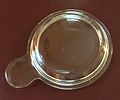This article needs additional citations for verification .(September 2018) |
Grab-it is a brand of Corning Ware cookware products easily identifiable by their uniform distinctive shape: a bowl with vertical sides and a rounded, concave tab handle. The name was first used for a versatile product which could safely go from refrigerator to stovetop, oven, broiler, or microwave, but later, inferior products, nearly identical in appearance but unsafe for stovetop or broiler use, were also branded as Corning Ware Grab-it. Before the introduction of the stoneware look-alike product, the Grab-it line was made of Pyroceram, a glass-ceramic material, by Corning Glass Works. [1] Grab-its are notable as being among the first cookware specifically designed for microwave use. Their original design was recognized by the Smithsonian's Cooper–Hewitt, National Design Museum. Grab-its strongly resemble porringers.
Contents
The original Grab-it (the P-150), introduced in 1976, was opaque white and had a capacity of 15 US fluid ounces (440 ml). [1] Later, the matching 24-US-fluid-ounce (710 ml) Grab-A-Meal (P-240) was introduced, with a small handle opposite the main one. This product was discontinued in 1986. Later, Visions Grab-its were introduced in 15-oz and 24-US-fluid-ounce (710 ml) sizes (V-155 and V-245, respectively), unifying the name for the two sizes. [2] The 15-ounce Grab-it was available with a plastic cover (for storage, allowing stacking) or a Pyrex glass lid (for storage or cooking use), or both, [2] while only a glass lid was available for the larger Grab-it and Grab-A-Meal. In addition to microwave use, Grab-its made of Pyroceram (i.e. earlier Corning Ware, and all Visions) are safe on the stovetop, in the oven, and (without cover) under a broiler.




